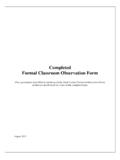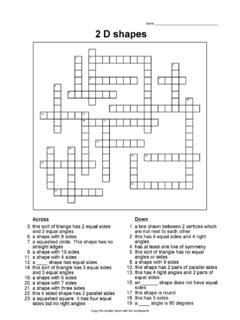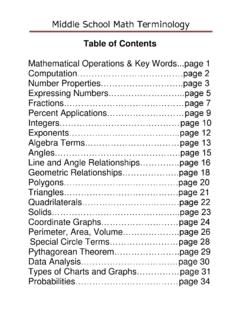Transcription of Geometry For Middle School Teachers
1 Geometry For Middle School Teachers A Professional Development Program to Implement the 2001 virginia Standards of Learning March 2004. Office of Middle Instructional Services virginia department of education Box 2120. Richmond, virginia 23218-2120. Copyright 2004 by the virginia department of education Box 2120. Richmond, virginia 23218-2120. All rights reserved. Reproduction of these materials for instructional purposes in virginia classrooms is permitted. Superintendent of Public Instruction Jo Lynne DeMary Assistant Superintendent for Instruction Patricia I. Wright Office of Middle Instructional Services James Firebaugh, Director Lois Williams, Middle Mathematics Specialist Office of Elementary Instructional Services Karen Grass, Elementary Mathematics Specialist Notice to Reader In accordance with the requirements of the Civil Rights Act and other federal and state laws and regulations, this document has been reviewed to ensure that it does not reflect stereotypes based on sex, race, or national origin.
2 The virginia department of education does not unlawfully discriminate on the basic of sex, race, age, color, religion, handicapping conditions, or national origin in employment or in its educational programs and activities. The activity that is the subject of this report was supported in whole or in part by the department of education . However, the opinions expressed herein do not necessarily reflect the position or policy of the department of education , and no official endorsement by the department of education should be inferred. virginia department of education ii Acknowledgements The virginia department of education wishes to express sincere appreciation to the following individuals who have contributed to the writing and editing of the activities in this document.
3 Margie Mason, Associate Professor The College of William and Mary Williamsburg, virginia Bruce Mason, Consultant Williamsburg, virginia Dana Johnson, Instructor The College of William and Mary Williamsburg, virginia Carol L. Rezba, Assistant Professor Longwood University Christa Southall Stafford County virginia department of education iii Introduction The updated Geometry for Middle School Teachers is a professional development program designed to assist Teachers in implementing the 2001 virginia Mathematics Standards of Learning. This professional development program provides a sample of meaningful and engaging activities correlated to the Geometry strand of the grades 6-8 Mathematics Standards of Learning. The purpose of the professional development program is to enhance Teachers '.
4 Content knowledge and their use of instructional strategies for teaching the Geometry strand of the Mathematics Standards of Learning. Teachers will learn about the van Hiele model for the development of geometric thought and how this can be used to guide instruction and classroom assessment. Through explorations, problem solving, and hands-on experiences, Teachers will engage in discussions and activities that address many of the dimensions of Geometry including spatial relationships, properties of geometric figures and solids, constructions, geometric modeling, geometric transformations, coordinate Geometry , the Geometry of measurement, informal geometric reasoning, and geometric connections to the physical world. Teachers will explore two- and three-dimensional figures, paper folding, tessellations, and the use of other manipulatives and technology to develop geometric understanding.
5 Through these activities, it is anticipated that Teachers will develop new techniques that assist in increasing student achievement in their classrooms. Designed to be presented by teacher trainers, this professional development program includes directions for the trainer, as well as the activity sheets for participants. An addendum to the module includes video segments of the van Hiele levels. These video segments portray students engaged in assessment tasks and can be used to discuss students' level of development of geometric thought. Directions for the assessment tasks are also included. Trainers should adapt the materials to best fit the needs of their audience; adding materials that may be more appropriate for their audience and eliminating materials that have been used in previous training sessions.
6 All materials in this document may be duplicated and distributed as desired for use in public schools in virginia . The training programs are organized into five modules that may be offered by School divisions for teacher licensure renewal points or for a one-credit graduate course, when university credit can be arranged. virginia department of education iv GLOSSARY. Acute Angle An angle with a measure greater than 0 degrees but less than 90. degrees. Acute Triangle A triangle with three acute angles (or no angle measuring 90 degrees or greater). Adjacent Sides Two sides of a polygon with a common vertex. Angle Two rays that share an endpoint. Arc Part of a circle. Area The amount of surface in a region or enclosed within a boundary. Area is measured in square units such as square feet or square centimeters.
7 Attribute A characteristic possessed by an object. Characteristics include shape, color, size, length, weight, capacity, area, etc. Base of a Solid A plane figure. If the solid is a cylinder or prism, there are two bases that are parallel and congruent. Centimeter A metric unit of length equal to one-hundredth of one meter. Circle A closed curve with all points in one plane and equidistant from a fixed point (the center). Circumference The length of the boundary of a circular region. The circumference can be computed by multiplying the diameter by pi ( ), a number a little more than Concentric Circles Two or more circles that have the same center and different radii. Cone A three-dimensional figure with one curved surface, one flat surface (usually circular), one curved edge, and one vertex.
8 Congruent Having exactly the same size and shape. Congruent polygons have their corresponding angles congruent and corresponding sides congruent. Coordinate System A reference system for locating and graphing points. In two dimensions, a coordinate system usually consists of a horizontal axis and a vertical axis, which intersect at the origin. Each point in the plane is located by its horizontal distance and vertical distance from the origin. These distances, or coordinates, form an ordered pair of numbers. Cube A solid figure in which every face is a square and every edge is the same length. virginia department of education v Glossary Cubic Foot The volume of a cube that is one foot wide, one foot high, and one foot long. Cubic Unit A unit of measure that has a length of one unit, a width of one unit, and a height of one unit used to measure volume.
9 Examples are cubic inches, cubic centimeters, etc. Cylinder A solid figure formed by two congruent parallel circles joined by a curved surface. Decagon A polygon with ten sides. A regular decagon has ten congruent sides and ten congruent angles. Diagonal A line segment that joins two non-adjacent vertices of a polygon or polyhedron. Diameter A line segment passing through the center of a circle or sphere and connecting two points on the circle or sphere. Diamond See Rhombus. Dimension The number of coordinates used to express a position. Dodecagon A polygon with twelve sides. A regular dodecagon has twelve congruent sides and twelve congruent angles. Dodecahedron A polyhedron with twelve faces. All faces of a regular dodecahedron are congruent, regular pentagons.
10 Edge A line segment where two faces of a three-dimensional figure intersect. Endpoint The point(s) at the end of a ray or line segment. Equilateral Triangle A triangle with three congruent sides. Each angle measures 60 degrees. Face A plane figure that serves as one side of a solid figure. Flip See Reflection. Geometry The branch of mathematics that deals with the position, size, and shape of figures. Grid A network of horizontal and vertical lines that intersect to form squares or rectangles. Hemisphere Half of a sphere, formed by making a plane cut through the center of a sphere. virginia department of education viii Glossary Heptagon A polygon with seven sides. A regular heptagon has seven congruent sides and seven congruent angles. Hexagon A polygon with six sides.














